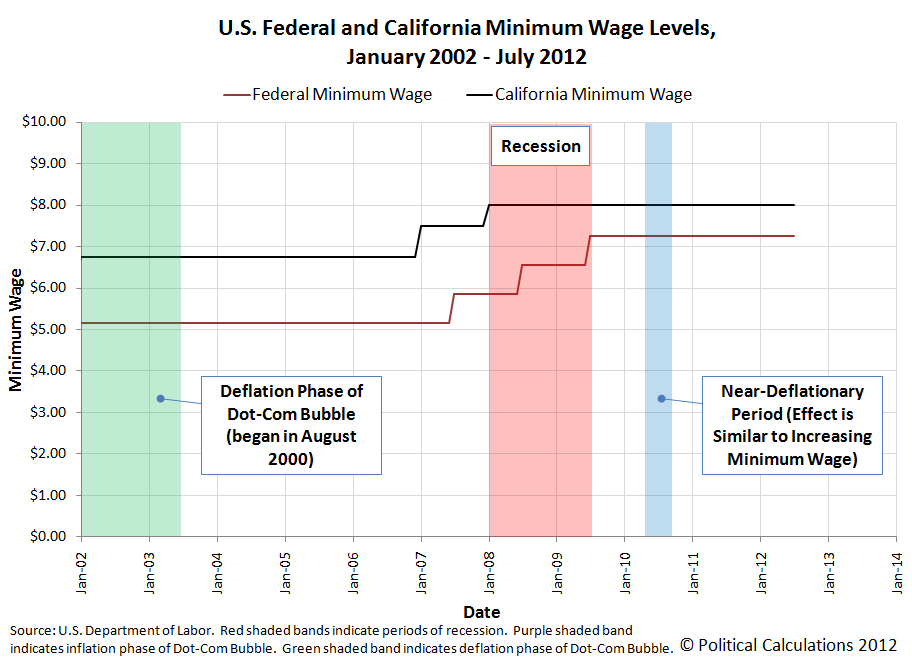After showing how only the reduction in the U.S. labor force participation rate has resulted in a lower unemployment rate last week, a number of commenters requested that we follow up and show how the minimum wage might factor into the situation.
So we whipped up three charts to look at the period from January 2002 through July 2012 [1]. First, here's the level of the minimum wage in both the U.S. and in California [2].
In the charts we're presenting today, we're indicating the deflation phase of the Dot-Com Bubble with the green shaded vertical band on the chart, official recession periods with the red shaded vertical band, and a period of time in which the U.S. was undergoing near-deflationary levels with the blue-shaded bands. Because deflation operates oppositely to inflation, it can result in effectively increasing the minimum wage while it reigns, even though there has been no actual change in the mandated minimum wage level.
Next, we looked at the labor force participation rate for the entire working age population (Age 16+) for the United States:
This data is identical to what we previously posted showing the change in the U.S. labor force participation rate from January 2002 through July 2012. Here, we see that declines in the labor force participation rate largely coincide with recessionary or deflationary periods, however we also note that outside these economic event, increases in the minimum wage (at the federal or state level) tend to also precede declines in the labor force participation rate.
In our next chart, we focused in on the labor force participation data for U.S. teens. This segment of the U.S. work force is the most likely to reveal correlations between the timing of minimum wage increases and changes in their labor force participation rate, because roughly one of ten working teens in the U.S. earn the U.S. federal minimum wage, who in turn, make up nearly one out of four members of the U.S. minimum wage earning work force.
Judge for yourself whether a causal relationship might exist between when a minimum wage increase occurs and when declines in the labor force participation rate take place.
Notes
[1] The choice of dates is arbitrary, and in this case, chosen by the Bureau of Labor Statistics data jocks, who have the default starting and ending years for their online database for the Current Population Survey set at 2002 and 2012 respectively. If you don't like it, well, go to their site and select your own dates to get the data to make your own charts.
[2] We're showing the U.S. federal and California minimum wage levels because California's minimum was so elevated with respect to the U.S. federal minimum wage during this period, and because California is home to one out of every eight Americans. That's a pretty large segment of the population, so what California does will show up in the national level labor force participation rate data. We should also note that a number of smaller population states set their minimum wage at levels similar to those of California during this period of time, with the result being that about one out of five Americans lived and worked in states with higher minimum wage levels than the federal minimum wage. For these reasons, we believe that changes in California's minimum wage level then will work as a fairly good proxy for this portion of the U.S. population.
Labels: jobs, minimum wage
Welcome to the blogosphere's toolchest! Here, unlike other blogs dedicated to analyzing current events, we create easy-to-use, simple tools to do the math related to them so you can get in on the action too! If you would like to learn more about these tools, or if you would like to contribute ideas to develop for this blog, please e-mail us at:
ironman at politicalcalculations
Thanks in advance!
Closing values for previous trading day.
This site is primarily powered by:
CSS Validation
RSS Site Feed
JavaScript
The tools on this site are built using JavaScript. If you would like to learn more, one of the best free resources on the web is available at W3Schools.com.


